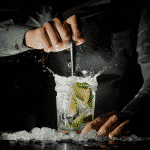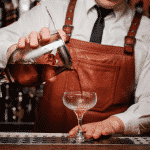You may have heard about the fights between Poland and Russian on the subject of the history of vodka.
Since vodka’s introduction into the West, it’s boasted of being tasteless & odourless.
Indeed the US government initially defined vodka as a clear, neutral spirit so distilled, or so treated after distillation with charcoal or other materials, as to be without discernible flavour or aroma.
Vodka’s earliest campaign in the West even claimed to “leave you breathless”. So, denied its heritage and introduced as the white whisky, vodka was a successful iconoclast and a certain hit with the young but denied any recognition of its own product realities.
Now, the EU defines vodka as a spirit in which the characteristics of their raw materials are selectively reduced and this defines, more accurately, many of the vodkas that emanate from the East and some of the more recent vodkas created in the West. These remain the purest of spirits while retaining some character from their raw materials.
Vodka, the world’s most popular spirit, remains pretty functional in the East where, historically, it’s usually been drunk neat, a refuge from life’s horrors and an aid to the digestion of fatty foods.
In the West, vodka’s been drunk more as a lifestyle statement than because of what’s in the bottle. So long as it was clean and neutral, few had reason to know about vodka’s product realities except perhaps its alcoholic strength.
The future looks very different as Westerners now call for so-called vodkas with character, whether they be traditional vodkas from the East or vodkas with taste, texture and aromatics, now distilled in the West.
[irp posts=”63″ name=”When You Learn About Vodka You Will Never Think They Are All The Same Again”]
History
Vodka is probably the world’s oldest spirit but Russians and Poles disagree about the origins and neither has the definitive evidence to support their claims.
Russia gave us the word ‘voda’, meaning water and ‘vodka’ meaning ‘little water ’ though Poland has similar words ‘woda’ and ‘wodka’.
The diminutive ‘ka’, when used in the middle ages, meant better, a description most likely true of vodka because water, at that time, not only tasted bad but could be very unhealthy too.
What is true is that Poland was distilling vodka for medical use by the 11th century and, by the 17th century, vodka was Poland’s national drink.
In Poland
3 copies of a lifestyle book, dated 1405, contain mention of how to infuse your “vodka” and in 1534 a Polish encyclopaedia of medicine & science explained how to distil herb vodkas and suggested using vodka to cleanse the skin after shaving or to rub on after a bath to remove unpleasant odours!
Making vodka was less restricted than in Russia and in 1546, King Jan Olbrecht issued a decree allowing every citizen the right to make vodka. As a result, distillation was very much a family affair, and by the sixteenth century there were 49 commercial distilleries in the town of Poznan alone. In the centuries that followed vodka distillation and consumption became established at all levels of Polish society and today Poznan remains a major centre for the production of vodka.
In Russia
Alcohol production was first documented in the 9th century, but spirits were thought to have arrived in Russia through Italian traders in the 14th century. Early distillations were likely for medicine or even gunpowder rather than for drinking but only a century later, a monopoly on distillation and sale of spirits was imposed in Moscow, suggesting that, by then, levels of consumption were already considerable. In the 1540s the Russian Tsar Ivan ‘the Terrible’ established his own network of distilling taverns, making sure that profits went straight into the Imperial treasury. He outlawed taverns that were outside his control and banned distilling by potential rivals. Always needing support from the nobility, however, he did allow them to continue distilling vodka.
High alcohol vodkas developed in cold Northern countries because in cold temperatures only high levels of alcohol ensured that the drinks remained liquid. Better still and much, to everyone’s surprise, the higher the level of alcohol, the more palatable the spirit. Distillation, however, was an imperfect science and so, in these early years, impurities remained in the finished spirit.
Successive rulers maintained their monopoly on vodka distillation but continued to grant distilling rights to the nobility and government officials. As their knowledge grew, the nobility tended towards the production of quality vodka while the peasantry made vodka of sorts for themselves, usually adding flavours to mask the raw spirit.
From the beginning of the 17th century, it had become customary for vodka to be served at Russian Imperial banquets and all formal meals began with bread and vodka. Vodka was also drunk at religious festivals. Peter the Great was renowned for his hospitality and love of drinking and, in his time, the Governor of Moscow was known to have trained a large bear to serve pepper Vodka to his guests or to remove the guests’ clothes, if they refused their drink.
In 1863 the government monopoly on production was repealed and Pyotr Smirnov, among others founded his distillery in Moscow. Until then vodkas had remained far from pure and the product of single distillation in pot stills but the Smirnov family pioneered charcoal filtration and, in the 1870s, were the first to use the continuous distillation process.
Success followed quickly with Smirnov, now the vodka of the Czars, reputably soon selling more than 4 million cases p.a. in Russia, thanks, in part, to the authoritarian Russian governments being more afraid of people thinking than drinking and so turning a blind eye to the widespread drunkenness. To assist the war effort, vodka distillation was banned in Russia in 1914. 3 years later the masses, no longer so drunk, rebelled and overthrew their government, no doubt encouraging Stalin to rediscover the ‘benefits’ the Czars had seen in cheap vodka during his reign of terror.
In Sweden
A distilling prodigy, Lars Olson Smith introduced continuous distillation and began to produce spirits with exceptionally low levels of impurities, particularly his Absolut Rent Brannvin, launched in 1879. Success earned him the title ‘King of Spirits’ but, still, vodka was not to gain broad success across Western Europe until the second half of the 20th century.
First, the Smirnov family fled the Russian Revolution and set up in Europe, changing their name to Smirnoff. They were not successful and sold their recipe to a family friend who had escaped to America. The recipe for Smirnoff arrived in America in 1934 and, though again, not initially successful, the ‘vodka’ experience of troops meeting Russian soldiers during World War 2 and clever marketing in the West, transformed vodka from a curious speciality from the East, into a fashion icon. From the 1950s onwards, Smirnoff drove the ‘breathless’ revolution and vodka became a global and stateless, truly international spirit, to be enjoyed more for the alcoholic kick it added to a mixer than for its own character.
clever marketing in the West, transformed vodka from a curious speciality from the East, into a fashion icon Click To TweetIt wasn’t until the approach of the 21st century that Westerners began to show interest in what was in the bottles but today, alongside neutral western vodkas, numerous traditional vodkas from the East are to be found as well as vodkas, distilled in the West, proud of their character, whether sourced from spring waters, local raw materials or process.
A choice can now be made between vodkas that represent a lifestyle choice and those, from the East & the West, that offer distinct product realities, whether in the vodka itself and/or in the vodka’s heritage and provenance.













Elliott
Great items from you, man. I have take into account your stuff prior to and you are just extremely excellent.
I really like what you’ve got here, really like what you
are saying and the way through which you assert it. You are making it enjoyable and you continue to care for to stay it sensible.
I cant wait to read much more from you. This is really a
terrific site.
Joel Mitchell
Great to hear Elliot,
Looking forward to hearing from you again in the future
Thanks
Mariel
Hello there I am so delighted I found your website, I really found you by error, while I was
researching on Bing for something else, Anyhow I am here now and would just like to say thank you for a marvelous post and a all round exciting blog (I also love the
theme/design), I don’t have time to browse it all at the moment but I have bookmarked it and also added
in your RSS feeds, so when I have time I will be back
to read a great deal more, Please do keep up the fantastic jo.
beabetterbartender
Hi there, we are very glad that you enjoy what you are reading. We hope to keep impressing you!
Thanks
JM – Be a better bartender team